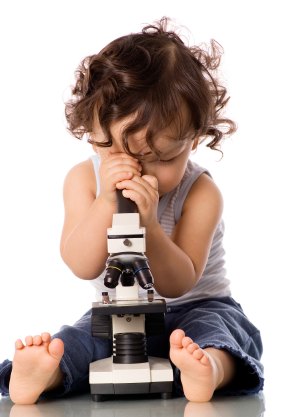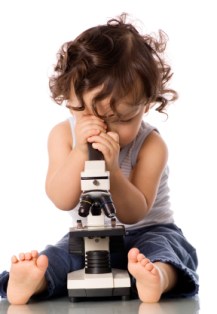
A version of this story first appeared in The Last Word on Nothing.
As the parent of a 3-year-old, I spend a lot of time reading kids’ books. Some are wonderful, a lot are so-so, and a few are so frigging annoying that — I confess — I hide them. As a science writer, I always expect to like science-themed books — this is my kind of brainwashing, I think — but lately, I’ve even packed a few of them off to the thrift store.
In uncharitable moments, I might gripe about these books’ bad artwork or mixed meters. But my real problem is with the way they present science. According to them, science is not, as my colleagues and I humbly remind you, The Last Word on Nothing. It’s an intimidating institution filled with intimidating grownups, all of whom have The Last Word on Pretty Much Everything. “Putting a dinosaur skeleton together takes hard work — and lots of special knowledge and skill,” one book intones.
If we’re not careful, we’ll end up living in a world that looks like this — and that is a truly scary prospect.
I was well into an undergraduate biology major before I grasped that science is not a pile of interesting facts, but a process — not the only way to learn about the world, but a very powerful one. I’d like my daughter to arrive at that realization a little sooner than I did. I’d also like her to know that she doesn’t need a Ph.D. to start thinking like a scientist.
Yes, in the official world of science, credentials do count, and in most cases they should. But kids should know that anyone can make observations, form hypotheses, and figure out how to test them. Anyone can have a eureka moment. Anyone can go on a voyage of discovery, even if it begins and ends in the town park.
I’ve started to think that the best books for budding scientists don’t lecture, teach, or even talk much about science. Instead, they find other ways to celebrate the crooked, fascinating path that is the scientific life. Below are a half dozen that get unanimous approval in my household.
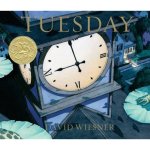 Tuesday by David Weisner. Late one Tuesday evening, a mob of frogs flies through town on lilypads, disappearing as quickly as it came. Why? This almost-wordless story doesn’t say, leaving kids free to form their own theories about spontaneous frog flight.
Tuesday by David Weisner. Late one Tuesday evening, a mob of frogs flies through town on lilypads, disappearing as quickly as it came. Why? This almost-wordless story doesn’t say, leaving kids free to form their own theories about spontaneous frog flight.
Owl Moon by Jane Yolen. A classic story about a backyard adventure, in which a young girl goes owling with her father. The great horned owl they finally see, unlike most animals in kids’ books, isn’t particularly friendly — it occupies a world apart. “For one minute, three minutes, maybe even a hundred minutes, we stared at one another,” the girl writes. One of the best introductions I know of to the mysteries of nature.
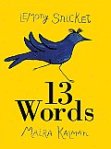 Thirteen Words by Maira Kalman and Lemony Snicket. Not your usual word-power book: The 13 words include not only “dog” and “bird,” but also “despondent” and “haberdashery,” and they’re eventually strung together to form a story and a song. Perfect practice in discovering the sense in seemingly nonsensical data. (And besides, it’s fun to hear your toddler say “panache.”)
Thirteen Words by Maira Kalman and Lemony Snicket. Not your usual word-power book: The 13 words include not only “dog” and “bird,” but also “despondent” and “haberdashery,” and they’re eventually strung together to form a story and a song. Perfect practice in discovering the sense in seemingly nonsensical data. (And besides, it’s fun to hear your toddler say “panache.”)
Miss Rumphius by Barbara Cooney. Though this book puts me on a mild invasive-species alert (a concern shared by my friend and fellow journalist Virginia Gewin), this is a lovely story of an adventurous life well lived. I especially like Miss Rumphius because — almost uniquely among female characters in kids’ books — she’s unmarried, has no children, and seems perfectly satisfied. Small investigators, particularly girls, should know that life comes with all kinds of options.
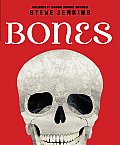 Bones: Skeletons and How they Work by Steve Jenkins. The text of Bones is a bit advanced for my daughter, but the illustrations are so good that she likes to look at it anyway. She loves comparing the bones in her own hand to those in a bat’s wing, and hearing that her ancestors had not just tailbones but tails. Bones is also great for inspiring hands-on research (dominant methods are pinching and tickling).
Bones: Skeletons and How they Work by Steve Jenkins. The text of Bones is a bit advanced for my daughter, but the illustrations are so good that she likes to look at it anyway. She loves comparing the bones in her own hand to those in a bat’s wing, and hearing that her ancestors had not just tailbones but tails. Bones is also great for inspiring hands-on research (dominant methods are pinching and tickling).
Far From Shore: Chronicles of an Open Ocean Voyage by Sophie Webb. Again, the text of this book is too complicated for my daughter, but she loves to look at the illustrations, which were painted by the author during a four-month-long Pacific research voyage. Webb describes her work in some depth, but she emphasizes not the results but the experience: the starlit nights on deck, the sightings of dolphins and whales and seabirds, and daily life with her fellow scientists. (She also includes details of high kid interest: “Since our toilets are flushed with seawater, if I flush the toilet in the dark it too will glitter with bioluminescent plankton.”)
Now, I’m looking forward to your reading recommendations. After all, my daughter is going to get suspicious about all those gaps on her bookshelf.

